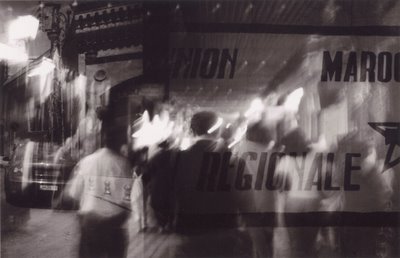Morocco Double-Exposures

There are about two dozen more of these images, taken during a trip through Morocco, September-October 2002, studies of light and proximity, architecture, routes and detours, space.

What I noticed in Marrakech almost immediately is that inside the networked markets that reflect one another through rows of glass lamps, bronze trinkets, polished rocks and small pieces of jewelry, laid out in tilted cases or stacked inside stalls, you find a collapse of expected proximities: everything's too close.

Toward the end of our trip, for instance, because of a gut parasite I'd picked up, I developed this insane fever that torqued the whole visual field into a funnel; then, while trying to figure out how I got that sick, we walked past a fruit stall – this was in Fes – immediately to the side of which, unprotected, out in the open, was a man taking a ball peen hammer to the skull of a dead cow, and chips of bone were flying everywhere, even landing on the fruit. People were buying the fruit, and serving it in restaurants.
Everything was too close, in other words; hygiene and distance became unexpected synonyms.

What's interesting, though, is when you get out of the cities and into the desert, and a kind of hydro-topographical narrative begins: while there's water in the coastal plains, collecting in small valleys or oases, and supporting urbanization, as you pass away on looping roads into the hills the entire continental shield seems to dry out. The rocks are abstract and red; Mars conspiracists could probably argue NASA's rovers are actually tootling around in the iron-rich void of central Morocco.
In any case, the continent is shattering; large rocks get smaller, weathered by thousands of years of wind and sandstorms – what Richard Fortey calls "the blast of erosion," in his awesomely great Earth – and you can actually watch as the terrain chips away at itself, getting closer and closer to the consistency of sand: sand which you then see on the horizon, in great dunes of the outer Sahara.
Meanwhile, you've passed over massive fissures in the earth, the planet breaking open, and so the twisting claustrophobia of the urban market has been replaced by its apparent opposite: geological time, ripped open right in front of you in stratigraphic abysses that can rival the Grand Canyon.
The continent is abrading to sand, there is no one in sight, the heat is amazing, and you've barely even set foot in the interior.
But you realize that the complexity of the local architecture, especially in the markets and casbahs – which any labyrinth aficionado would fall in love with right away (I fell in love right away) – is not only a kind of terrestrial tactic, i.e. keeping small pieces of the planet (sand) out of the inner rooms, it's also a philosophical response to the utterly gigantic north African landscapes collapsing all over themselves, ground down to sandy fissures in the distance: you want to control space, and limit the perimeter. Keep the walls close.

Whole rooms, entire buildings, seem to overlap with everything else – till it's like walking through double-exposures.
(All images: Geoff Manaugh/BLDGBLOG; please link/credit if using elsewhere!)





Comments are moderated.
If it's not spam, it will appear here shortly!
These were taken with a Lomo, on 100 speed black & white film, in case you're wondering. Any presence of color in the above versions comes because I scanned the images as color photographs, then contrast-corrected and color-balanced them.
When I was in Fez several years back, I was particularly struck by the massive open-air tannery smack in the middle of the city. A minor "sacrifice zone" of unprocessed hides and huge open curing vats, borders pushing right up against the surrounding residential buildings and shops -- a very disorienting sight, like a double-exposure photo of a strip-mine's runoff pools superimposed on an urban apartment block.
Post a Comment